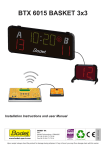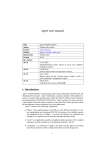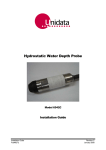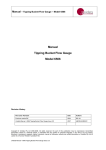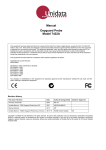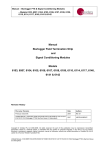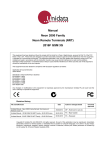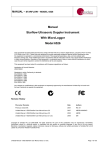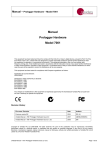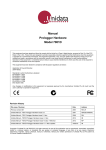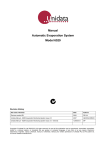Download Manual 4 Channel Relay Control Module Model 6525
Transcript
Manual – 4 Channel Relay Control Module – Model 6525 Manual 4 Channel Relay Control Module Model 6525 Revision History File name / Revision Date Authors Previous version BX 2004 RS/ JH Unidata Manual - 6525 4 Channel Relay Control Module User Manual Issue 2.0 2007 AB/CB/JH/MS/KC Copyright © Unidata Pty Ltd 2000-2008. All rights reserved. No part of this publication may be reproduced, transmitted, transcribed, stored in a retrieval system, or translated into any spoken or computer language, in any form or by any means. Electronic, mechanical, magnetic, optical, chemical, manual or otherwise, without prior written permission of Unidata Pty Ltd 40 Ladner St, O’Connor Western Australia 6163. Unidata Manual - 6525 4 Channel Relay Control Module User Manual Issue 2.0 Table of Contents 1. INTRODUCTION . . . . . . . . . . . . . . . . . . . . . . . . . . . . . . 1 2. CONTROLLING THE RELAYS . . . . . . . . . . . . . . . . . . 2 2.1. The High Speed Bi-Directional Serial Port . . . . . . . . . . . . . 2 2.2. 2.2.1. 2.2.2. 2.2.3. 2.2.4. 2.2.5. 2.2.6. Programming the Relays . . . . . . . . . . . . . . . . . . . . . . . . . . . 3 Step 1: Create and Save a Scheme . . . . . . . . . . . . . . . . . . . . 3 Step 2: Decide When to Open and Close the Relays . . . . . . . 3 Step 3: Identify Addresses and Choose Instructions . . . . . . . 5 Step 4: Modify the Logger Program file . . . . . . . . . . . . . . . . . . 6 Step 5: Assemble the Logger Program File . . . . . . . . . . . . . . 6 Step 6: Load the Scheme into the Logger . . . . . . . . . . . . . . . . 7 2.3 Serial Communications Instructions . . . . . . . . . . . . . . . . . . 7 3. CONNECTIONS . . . . . . . . . . . . . . . . . . . . . . . . . . . . . . 8 4. TEST PROGRAM . . . . . . . . . . . . . . . . . . . . . . . . . . . . . 9 5. SPECIFICATIONS . . . . . . . . . . . . . . . . . . . . . . . . . . . 10 Contents – i ii – Contents 1. INTRODUCTION The 4-Channel Relay Control Module (Model 6525A) is an interface designed to allow the Data Logger to control four magnetically latched relays. This permits a UNIDATA STARLOG Data Logger to be used as a controller of four external devices through the four potential free contacts. Up to two modules can be connected to a Portable Data Logger and up to four to a MACRO Logger or STARLOGGER. Model 6525A 4-Channel Relay Control Module INTRODUCTION – 1 2. CONTROLLING THE RELAYS The 4 Channel Relay Control Module is controlled by the Data Logger. The Logger provides power to the module as well as controlling the relays. The scan synchronised power source – offered by both the Portable and MACRO Data Logger – provides power to the module. (See Connections, section 3.) This source switches on with every scan. Each relay is controlled by command from the Data Logger using one of the High Speed Bi-Directional Serial Ports. The commands sent from Logger to Module tell the Module which relay(s) to activate. These commands are first interpreted by the module, then implemented when the Logger sends a pulse to the Module. 2.1. The High Speed Bi-Directional Serial Port The High Speed Serial Port consists of a DATA line and a CLOCK line. The CLOCK enables commands sent on the serial DATA line to be interpreted correctly by the module. Each logger scan, the Serial Ports are read. The Sync signal (Pin 13 of the STARLOGGER, for instance) is used to indicate to the remote equipment that a logger read scan is about to begin. This signal is usually used to load the serial shift register(s) in the remote equipment in preparation of being read. The STARLOGGER and MACRO Data Logger offer two bi-directional serial data ports, DATA 1 and DATA 0. The Portable Data Logger provides one bi-directional data port, DATA 1. Either CLOCK 0 or CLOCK 1 can be used with DATA 1. The Portable Data Logger’s DATA 0 is unsuitable because it cannot be used to send data. The examples and explanations in this supplement assume you are using DATA 1 and CLOCK 1. 2 – CONTROLLING THE RELAYS 2.2. Programming the Relays This section provides a simple example of how to program the relays. In some cases, the skills of an experienced Programmer may be necessary. In summary, the procedure of programming the module is: 1. Create and Save a Scheme. 2. Decide when you want to open and close the relays. 3. Identify which addresses in Data Logger memory will be used and which instructions you’ll require – usually, JUMP (and its variations), LOAD, SEROUT and PULSE. (Refer to the STARLOG Programming supplement 6201.) 4. Use an ASCII editor to modify the Logger Program file, SCHEME.SRC. Add the instructions in the appropriate places. Save the file. 5. Use PDLASM to assemble the revised file. 5. Finally, load the Scheme into the Logger. 2.2.1. Step 1: Create and Save a Scheme In this example, two of the relays on the 4-Channel Relay Control Module are used to operate alarms when the water level of a river is either very high or very low. A Hydrostatic Water Depth & Temperature Probe (model 6508A) connected to a Portable Data Logger is used to monitor water level in the river. The Scheme: Every 5 seconds (scan rate) data from the probe is being sent to a Portable Data Logger on Analog Channel 0 (a0). Using the STARLOG Software Package create a Scheme which includes the above details. You will also want to include when and what to log and how to present the data, like in a report or a plot. (See the STARLOG Users Manual.) 2.2.2. Step 2: Decide When to Open and Close the Relays The river height is usually approximately 1⁄2 metre. If it drops to 25 cm, then the cattle will have to be moved into a paddock with a dam. On the other hand, if the river rises to 75 cm, then the pump will have to be relocated. When the probe measures 25 cm or less we want to trigger the LOW alarm. When the probe reads 75 cm or higher we want to trigger the HIGH alarm. Data from the Water Depth Probe on Analog Channel 0 is temporarily stored in the Logger’s Hardware Register in Address 16 (the address for a0). It is this CONTROLLING THE RELAYS – 3 reading that we will use to trigger the alarms. Therefore, the readings in address * This is a value which 16 which will trigger the alarms are: corresponds to actual Label Actual Height As Read by Logger * High 75 cm 191 Low 25 cm 63 height on a scale from 0 to 255 where 0 is 0 metre and 255 is 1 metre. In this example you will connect the High River alarm to Relay 0 and the Low River alarm to Relay 1. You will want Relay 0 to open when data in Address 16 read water level put level at address 16 (= 0 - 255) compare address 16 with upper limit is level > upper limit ? YES activate high river alarm RELAY 0 NO compare address 16 with lower limit is level < lower limit ? YES activate low river alarm RELAY 1 NO de-activate both alarms exit 4 – CONTROLLING THE RELAYS reads 191 or greater. This sets off the High River Alarm. Likewise, you will want Relay 1 to open when the data in Address 16 reads 63 or less. This sets off the Low River alarm. A flow diagram (below) illustrates this process. 2.2.3. Step 3: Identify Addresses and Choose Instructions You already know that you want to compare data in address 16. Now you have to select an unused address in the Logger Hardware Register into which the control byte for the Relay Module is written. In this example, you will use address 90. Instructions are listed in detail in the STARLOG Programming supplement 6201. For this application, you are most likely to use JUMP (and its variations), LOAD, 7 6 5 RL3 OFF RL3 ON 1 = TRUE 4 RL2 RL2 OFF ON 3 2 RL1 RL1 OFF ON 1 0 RL0 RL0 OFF ON 0 = FALSE SEROUT and PULSE. The control data is given to the module using the SEROUT instruction and then output to the relays by a 10 milli-second pulse using the PULSE instruction. The control byte is of the following form: i.e., Relay 0 = ON = 0000 0001 = 1 Relay 0 = OFF = 0000 0010 = 2 Relay 1 = ON = 0000 0100 = 4 Relay 1 = OFF = 0000 1000 = 8 Relay 2 = ON = 0001 0000 = 16 Relay 2 = OFF = 0010 0000 = 32 Relay 3 = ON = 0100 0000 = 64 Relay 3 = OFF = 1000 0000 = 128 eg, relays 0 and 3 OFF, 1 and 2 ON output byte = 1001 0110 = 150 = 2 + 4 + 16 + 128 CONTROLLING THE RELAYS – 5 2.2.4. Step 4: Modify the Logger Program file In order for the Logger to control the Relays, you will want to add a few lines to the Logger Program file. This is the file which is generated by the Software Package each time you Save a Scheme. It is given the Scheme Name followed by the extension .SRC. For instance, the Logger Program file for a Scheme called RIVER would be: RIVER.SRC The Logger Program file is an ASCII file. To add the lines which control the Relay Module use a word processor which can edit and save ASCII files. The lines you will add to RIVER.SRC for this example are: SCAN: JMPGE 16,#191, HIGH JMPLE 16, #63, LOW LOAD 90, #170 LOW: JMP RELAY LOAD 90, #9 JMP RELAY LOAD 90,#6 RELAY: MOVWW 9,#8208 HIGH: SEROUT #1,90 (jump to HIGH if the) (value in address 16 is) (greater than or equal to 191) (jump to LOW if the value) (in address 16 is less than) (or equal to 191) (Load into address 90) (the control byte 170) (which means all relays off) (Jump to RELAY) (Relay 1 Off, Relay 0 On) (Jump to RELAY) (Load 6 into address 90) (Relay 0 Off, Relay 1 On) (Prepares the Logger to) (DATA 1 and CLOCK 1) (Send 1 byte from address) (90 to the module) PULSE #45 EXIT Finally, save the RIVER.SRC file. 2.2.5. Step 5: Assemble the Logger Program File Once the Logger Program file has been modified and saved you will want to use the Assembler in STARLOG Software to assemble it before you load the Scheme into a Logger. In the current working directory, type the command: PDLASM RIVER.SRC 6 – CONTROLLING THE RELAYS 2.2.6. Step 6: Load the Scheme into the Logger Using the menu-driven STARLOG Software Package select Use a Scheme from the main menu, then Choose a Scheme and finally, Program Logger with Scheme. Remember that if you at any time modify the Scheme using the menus, you will need to once again add commands to the Scheme Program file and assemble it in order to use the 4-Channel Relay Control Module. 2.3. Serial Communication Instructions The Logger provides the following instructions for serial communications: SERIN, SEROUT SERIN0, SEROUT0 SERIN1, SEROUT1 all Loggers DATA0 used for DATA0 in MACRO Logger and STARLOGGER used for DATA1 in MACRO Logger and STARLOGGER SERIN x,y,z (SERIN0 and SERIN1) extract x bytes of serial data from the specified data line and store that data in Block z, Locations y, y+1 ... y+x. eg, SERIN 4,50,1 = 72,4,50,1 will cause four bytes of data to be read and stored in Block 1, Location 50 to Block 1, Location 53 (addresses 306 - 309). SEROUT x,y,z (SEROUT0 and SEROUT1) is similar to the SERIN instruction except that data is taken from Block z, Location y etc. and output on the appropriate data line. Another variation of the above two instructions allows the user to ’point’ to the address where the data will come from/go to, ie y contains the address of a pointer to the actual data area. Further to the above instructions, it must be specified which DATA and CLOCK lines are being used. This is done by placing particular data in addresses 8, 9 and 10. Address 8 = Address 9 = Address 9 = Address 10= 32 if CLOCK 1 is used, (A8=0 if not) 16 if DATA 1 is used, 128 if DATA 0 is used, 64 if CLOCK 0 is used, (A10=0 if not) CONTROLLING THE RELAYS – 7 3. CONNECTIONS 4-Channel Relay Control Module Terminal Function 1 PULSE 2 CLOCK 1 3 DATA 1 4 GND 5 +5V 6 RELAY 0 output 7 RELAY 0 output 8 RELAY 1 output 9 RELAY 1 output 10 RELAY 2 output 11 RELAY 2 output 12 RELAY 3 output 13 RELAY 3 output Portable Data Logger Pin Term. 17 42 22 13 10 45 23 10 13 15,16,17 MACRO Data Logger Pin Term. 33 9 13 16 31 15 17 13 18 49 External Connection 5 4 3 2 1 0 6 7 1 8 9 2 10 11 3 12 13 4-Way Relay Module Layout 8 – CONNECTIONS 4. TEST PROGRAM You can use the Test a Logger menus in STARLOG Software to check the operation of the module. Use the PDL Information menu and the PUT and ADDRESS commnads to enter the following data. PDL only, not needed for a MACRO Logger. Address 8 : 0,16,32,0 (for DATA 1 and CLOCK 1) Address 51 : 170 Address 384 : 8,4,1,6,76,1,50,0 Address 392 : 24,0,45,0,0,0,0,0 These numbers are 77 for a MACRO Logger Address 400 : 76,1,51,0,24,0,30,0 Address 408 : 0,0,0,0 Then, by putting the following at address 50, each relay can be turned on and off, each log cycle, in turn. Address 50 : 1 (relay 0) 4 (relay 1) 16 (relay 2) 64 (relay 3) TEST PROGRAM – 9 5. SPECIFICATIONS Dimensions: Input: Output: Power Usage: Relay Contact Ratings: 10 – SPECIFICATIONS 75mm x 125mm x 80mm programmable output control from Logger potential free latched relay contact (DPDT) 2mA max. 240V AC @ 0.5 A max.















